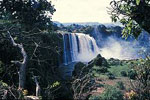|
|
|

|
Global
Health
Ethiopia—a country with 13 months of sunshine
|
by Mulugeta
Gebregziabher and Abeba Teklehaimanot
Ethiopia’s history dates back to the third century B.C. It is
characterized by a mosaic of diverse cultures and people who speak more
than 80 languages. As the cradle of the human race, it has more UNESCO
(United Nations Educational, Scientific and Cultural Organization)
registered world-heritage sites than any other country. It follows a
13-month lunar calendar with each month lasting 30 days, except the
30th month of five days (six days if it’s a leap year). Consequently,
it is now 2002 instead of 2010.
 “Lucy” (after the
Beatles’ song “Lucy in the Sky with Diamonds”) was found in 1974. “Lucy” (after the
Beatles’ song “Lucy in the Sky with Diamonds”) was found in 1974.
Recent archeological and genetic evidences suggest that the origin of
the human race is from Ethiopia. In October 2009, scientists announced
the discovery of the oldest fossil skeleton of a human ancestor, Ardi
(4.4 million years old), which revealed that our forebears underwent a
previously unknown stage of evolution more than a million years before
Lucy, the iconic early human ancestor specimen that walked the earth
3.2 million years ago.
Ardi was discovered in Ethiopia at a site called Aramis, just 46 miles
from where Lucy was found in 1974. Lucy is currently traveling to
museums in the United States, introducing Americans to Ethiopia and its
past and future. Two recent studies in Science and Nature (Li JZ et al.
2008; Jakobsson, M. et al. 2008) looking at worldwide, genetic
diversity have also shown that humans spread around the globe through a
series of migrations that originated from a location near Addis Ababa,
Ethiopia.
 The Blue Nile is a
river originating at Lake Tana in Ethiopia. With the White Nile, the
river is one of the two major tributaries of the Nile. The upper
reaches of the river is called the Abbay in Ethiopia, where it is
considered holy by many, and is believed to be the River Gihon
mentioned as flowing out of the Garden of Eden in Genesis 2. The Blue Nile is a
river originating at Lake Tana in Ethiopia. With the White Nile, the
river is one of the two major tributaries of the Nile. The upper
reaches of the river is called the Abbay in Ethiopia, where it is
considered holy by many, and is believed to be the River Gihon
mentioned as flowing out of the Garden of Eden in Genesis 2.
Ethiopia enjoys 13 months of sunshine and is home to the Arc of the
Covenant, rock-hewn churches, caves and monuments carved from a single
stone that date back to the fourth century. It is also home to the Blue
Nile which is one the longest flowing rivers and a thirst quencher to
the Sudan and Egypt. Its capital city, Addis Ababa, at an
altitude of 8,000 feet, is the seat of the African Union, with the
designation as being ‘the Capital City of Africa.’
Ethiopia is one of the most attractive destinations for tourists
interested in nature, history and culture. It is safe and relatively
cheap with daily direct flights from Washington, D.C., through
Ethiopian Airlines. Unfortunately, the average person knows a ‘single
story’ about Ethiopia regarding famine and war because of the unfair
coverage of events by Western media.
The challenges Ethiopia faces are multifaceted: low life expectancy at
birth (55 years for males and 58 years, female), high child mortality
(123 out of 1,000 live births) and high prevalence of infectious
diseases. Against all these odds, Ethiopia has recently embarked on a
strong path of development with its economy registering more than 10
percent growth for the last five years, the second fastest in Africa.
In fact, Ethiopia is poised to meet all components of the Millennium
Development Goals (MDG) set by the United Nations.
Thus, Ethiopia poses a great opportunity for the MUSC community in
global health collaboration and outreach to attain and maintain the
MDG. There are gaps in the areas of maternal mortality, heart disease,
neurological and head-neck disorders.
Facts
- Ethiopia is about twice the size of Texas with
a population of more than 80 million
- Origin of human species and coffee
- The only African nation that has its own
alphabet and numerals
- Home to the hottest inhabited place on earth,
Dallol
- The only country in Africa that has never been
colonialized by any foreign power
Clinician’s corner
An 8-year-old male recently adopted from Ethiopia presents with
complaints of painless, gross hematuria. His examination was within
normal limits. A urinalysis revealed >50 red blood cells and six to
10 white blood cells per high-powered field. A urine culture was
negative. A complete blood count was significant for a normal
hemoglobin and white blood cell count of 11,500 with an absolute
eosinophil count of 3,700. Which of the following tests would most
likely reveal the diagnosis?
A) Renal ultrasound
B) Urine ova and parasite
C) Cystoscopy
D) Stool ova and parasite
The correct answer is “B” urine ova and parasite, which is the
recommended diagnostic test when Schistomoma hematobium is suspected.
Urinary schistosomiasis is a serious parasitic infection in the tropics
and is especially common in Ethiopia. Patients usually present with
painless, gross hematuria and eosinophilia. Identifying and treating
urinary schistosomiasis is important to decrease the risk of
complications such as obstructive uropathy and bladder carcinoma.
Treatment with praziquantel usually results in resolution of symptoms
as well as eradication of all stages of schistosomes.
Editor's
note:
The
Global
Health page focuses on raising awareness of
international health issues through an academic venue with the purpose
of improving the quality of care for patients. E-mail
globalhealthnews@musc.edu.
Friday, May 7, 2010
|
|
|




